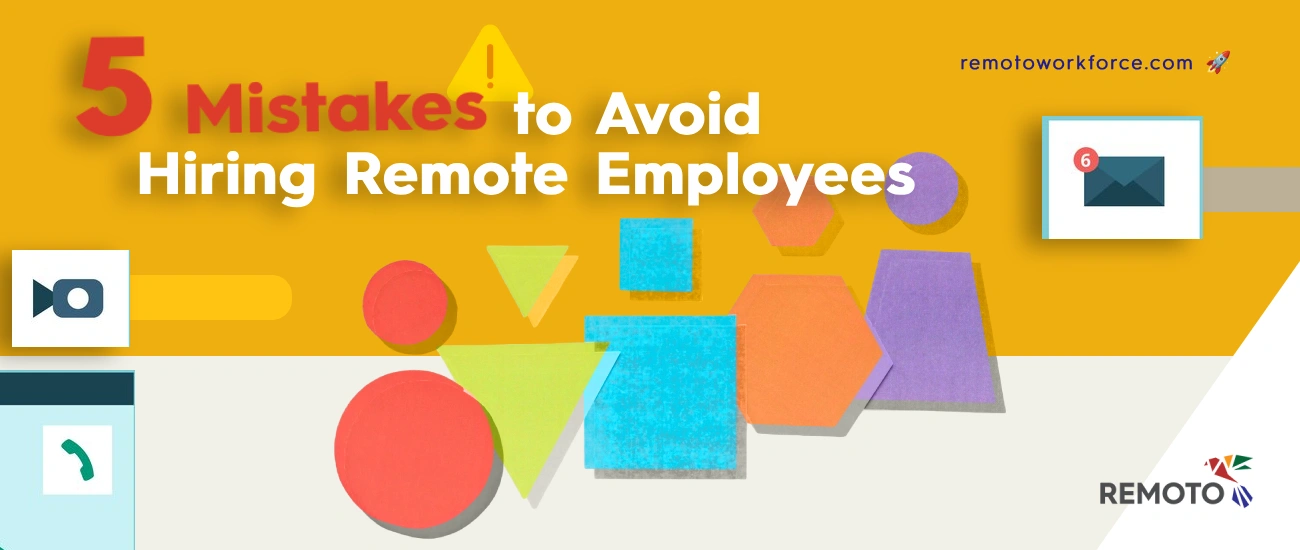Remote work has changed how businesses work and find good people. It gives companies great chances to connect with skilled professionals around the world. However, hiring remote employees isn’t without its challenges. As businesses embrace remote work, it’s crucial to avoid common pitfalls that could hinder the productivity and success of your remote team.
Here’s a look at five mistakes to steer clear of, ensuring you build a high-performing, motivated, and well-integrated remote workforce.
Skipping the Cultural Fit Test: The Silent Productivity Killer
When hiring remote employees, it’s tempting to focus solely on technical skills or experience. Neglecting cultural fit can lead to significant problems down the line.
Imagine onboarding a stellar developer who clashes with your team’s values or communication style. Sure, they can code like a wizard, but if they disrupt collaboration, the cost outweighs the benefit.
Cultural fit doesn’t mean hiring clones of your existing team. Instead, look for candidates who align with your company’s core values while bringing diversity of thought and perspective. Use behavioral interview questions to assess how they handle conflict, adapt to change, or collaborate in teams.
Also, consider the nuances of remote work culture. Does your candidate thrive independently? Are they comfortable working asynchronously? Addressing these questions during the hiring process ensures a smoother integration and a harmonious virtual workplace.
Ignoring Clear Role Definitions: The Recipe for Chaos
One of the fastest ways to derail a remote hire is by failing to provide a clear and detailed role definition. Without understanding their responsibilities, expectations, and deliverables, remote employees are left navigating in the dark—and your business pays the price.
Before posting a job ad, map out the role in detail. Highlight not only the technical skills required but also the soft skills that complement remote work, like time management and self-discipline.
Be explicit about the metrics for success. Will the role involve frequent video calls, or is most communication asynchronous? Do deadlines have some flexibility, or is strict adherence to timelines non-negotiable?
During onboarding, reinforce these expectations. A strong start sets the tone for accountability and reduces misunderstandings. Clarity isn’t micromanagement—it’s empowerment.
Overlooking Communication Skills: The Glue of Remote Teams
In a remote setup, communication can make or break success. Remote employees need to be good at explaining their ideas clearly, whether through email, chat, or virtual meetings. This is because they don’t have to meet in person. Yet, communication skills are often underestimated during the hiring process.
When interviewing candidates, assess how they convey their ideas. Do they provide structured and concise answers? Are they comfortable explaining complex concepts in simple terms? Simulate remote work scenarios by asking them to draft an email response to a hypothetical problem or create a brief presentation on a relevant topic.
Beyond hiring, invest in tools and practices that enhance team communication. Platforms like Slack, Asana, or Microsoft Teams are great, but they’re not magic wands. Establish norms for their use, such as when to escalate an issue from a chat to a video call. And don’t forget the human touch—regular check-ins foster trust and camaraderie.
Focusing Too Much on Cost: The False Economy Trap
Remote work is often lauded for its cost-saving potential. After all, hiring from lower-cost regions can stretch your budget further, right? While financial considerations are valid, prioritizing cost above all else can lead to costly mistakes in the long run.
Hiring the cheapest talent available might save dollars upfront but could result in underqualified employees, high turnover, or quality issues that damage your reputation.
Instead, strike a balance between budget and value. What does this candidate bring to the table that others don’t? Are they experienced in remote work? Do they offer specialized skills that align with your long-term goals?
Remember, investing in top-notch talent pays dividends over time. A well-qualified remote employee is more likely to deliver exceptional results, stay committed, and elevate your team’s performance.
Forgetting to Build Connection: The Path to Isolation and Burnout
Remote employees often face unique challenges, like feelings of isolation or disconnection from the company’s mission. If you neglect fostering connection, you risk losing valuable talent—not to mention the hit to morale and productivity.
To counter this, prioritize creating a sense of belonging. Schedule virtual team-building activities, celebrate wins publicly (even small ones), and encourage managers to check in on their team members’ well-being. These gestures don’t have to be grand but they must be intentional.
Additionally, provide opportunities for professional growth. Remote employees should feel they’re part of the bigger picture, not just cogs in a machine. Offer training programs, mentorship, or pathways to advance their careers. When employees feel valued and included, they’re far more likely to stay engaged and loyal.
Build Your Remote Dream Team the Right Way
Hiring remote employees is an art and a science. Avoiding these five mistakes—ignoring cultural fit, skipping role clarity, undervaluing communication, over-prioritizing cost, and neglecting connection—sets the stage for success.
Remember, remote work isn’t just about working from anywhere; it’s about creating an environment where everyone can thrive, regardless of location.
By investing time and effort into a thoughtful hiring process, you’ll not only find the right talent but also build a resilient, motivated, and high-performing team ready to tackle challenges head-on. Your remote employees aren’t just workers—they’re ambassadors of your company’s culture and the backbone of your business’s future.














